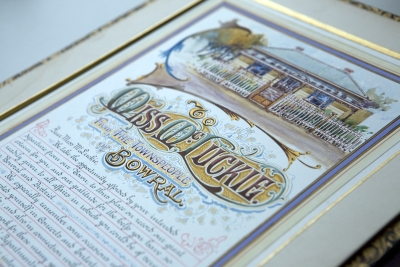Stories
 Miss Campbell McLuckie 1856-1932
Miss Campbell McLuckie 1856-1932
An Illuminated address, as well as an elegant silver salver was presented to Miss Campbell McLuckie on 6th September 1900 by Mr Gavin George, President of the Bowral Musical Society and Mayor of Bowral Municipal Council, Alf Stephens, at the Association Hall Bowral. It was presented on the occasion of her impending marriage to Canadian born Andrew Dean and their subsequent move to Canada.
The Bowral Presbyterian Church also presented an address to both Campbell and Campbell’s father, Thomas, to show their esteem for the father and daughter and to mark their departure from the area.
Miss McLuckie, was born in Calcutta, India in about 1856 to her Australian mother Mary (nee Miller) and Scottish father Thomas McLuckie. Thomas was a teacher at Doveton College Calcutta when Mary contracted cholera and tragically died in 1856. Campbell was just an infant. Grief stricken, Thomas returned to Scotland with baby Campbell and remained there until migrating to Australia as Unassisted Immigrants on the Chimborazo in June 1883. They lived for some time in Sydney and Parramatta, then moved to Bowral in 1890. Miss McLuckie became headmistress of Bowral Infants School and later was promoted to headmistress of Bowral Superior school.
Thomas and his daughter lived in a house named “Araneath” in Woodbine Street, Bowral, thought to be the house depicted in the illuminated address. Both Thomas and Campbell were well liked and respected members of the Presbyterian Church. Campbell was well known in the community as a pianist and for her musical talents.
Miss Mcluckie, aged 43 married Andrew Lewis Dean, aged 44 on September 12 1900 in the Bowral Presbyterian Church. They then made their home in British Columbia, Canada. Thomas accompanied them.
Most probably, because of career opportunities, the family left Canada for Queenstown, Tasmania in about 1903 where Andrew took up the position of chief metalurgist at the Mount Lyell Mine, the first successful fully pyritic smelting operation in the world. They named their home in Queenstown after the Bowral home,“Araneath”.
The Deans returned to Vancouver in 1913, however Thomas did not accompany them as he died in 1905. He was buried in the Queenstown General cemetery in Lyell.
Both Campbell and Andrew lived out their lives quietly in Vancouver. They died in Oak Bay, Canada, Andrew on 23 December 1931, aged 75 years and Campbell on 10 June 1932, also aged 75 years.
They had no children, so after Campbell’s death some of their possessions were stored in the attic of family friends, the Luttrells.
It was 48 years later when Notary Mr K.C.S Luttrell found the Dean’s long hidden possessions in the attic of his family home. The discovery included the addresses presented to Campbell and Thomas.
Mr Luttrell approached Bowral Municipal Council by letter, asking if they would like the testimonials returned to the town.
Bowral Municipal Council unanimously accepted the offer made by Mr Luttrell and both testimonials were returned to Bowral in 1978, 46 years after Campbell’s death.
 What was an Illuminated Address and how were these used in early Australia?
What was an Illuminated Address and how were these used in early Australia?
From 1870 to 1930, the Illuminated Address was a popular form of presentation made to individuals to offer thanks, mark special occasions such as welcomes, farewells, condolences, congratulations, retirements or to recognize special achievements or outstanding service.
They ranged from the simple to the heavily ornate. Despite this diversity, there was a common language and look to those of the period:
- The wording was very formal and was used to praise the addressee. Words like “gratitude”, “esteem”, “service” and “appreciation” were commonly used.
- These sentiments were expressed in illuminated script and pages were decorated with gold edging and colours and iconography typical of the book of hours of the Middle Ages.
- Painted or photographic images meaningful to the addressee were also included.
- They were created as a unique historical keepsake for the recipient and as such were often lavishly bound in a gold embossed leather cover with the name of the recipient and date of the presentation also stamped in gold.
- The address was generally signed by notable people of the community.
- They were a unique gift and the time, care, research and expense that went into commissioning one of these works from specialist companies was evident.
Colonial illumination companies used a process which combined manual artistry with chromolithography which was an early type of lithographic colour printing process. It was less laborious than hand colouring, but still required separate plates for each colour, often in excess of 20 plates for each image.
Illuminated Addresses provide a valuable insight into the life of the recipient and also provide a useful and rich historical context to the social life and conditions of Australia and its people in the late 19th and early 20th century.
Wingecarribee Public Library’s Archives and Local Studies Room is home to three illuminated addresses, two of which were presented to Miss Campbell McLuckie.
